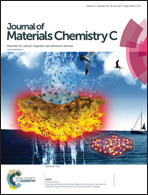Patterned films from exfoliated two-dimensional transition metal dichalcogenides assembled at a liquid–liquid interface†
Abstract
Highly controlled deposition of exfoliated transition metal dichalcogenide (TMD) suspensions onto substrates is an important step for the creation of efficient and scalable energy, electronic, optical and sensing units. Traditional methods such as drop casting and spin coating generally result in non-uniform deposition. Some methods also require the incorporation of surfactants or initiator molecules, which contaminate the particles and require extra processing steps. Here we present a facile method for controlled and patterned deposition of films made of exfoliated TMDs over large areas. A liquid–liquid interface is achieved directly from the nanoflake suspension in dimethyl formamide, without addition of any surfactants or chemical modifiers. We demonstrate the reliable and large scale patterning of macroscopic uniform films from exfoliated TMDs, through the use of hydrophobically patterned substrates. Microcharacterisations show that the TMD nanoflakes assemble through edge-to-edge arrangement into densely-packed thin films. Additionally, heterofilms were also successfully demonstrated using the same liquid–liquid interface method, through simply mixing exfoliated MoS2 and WS2 suspensions together before film assembly. This fast approach to TMD thin film assembly provides a future platform for reliable controlled deposition and co-patterning of 2D materials on a large scale compatible with industrial standards.



 Please wait while we load your content...
Please wait while we load your content...